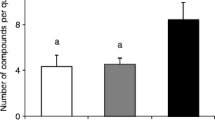Abstract
The effect of enantiomers of the queen-produced substance, 9-hydroxy-(E)-2-decenoic acid (9HDA) on swarm clustering behavior of the honeybeeApis mellifera was studied. Caged queens were removed from the swarms at the start of each test and were replaced with small Petri dishes containing one of the following treatments: 100 μgS(+) enantiomer of 9HDA, 100 μgR(-) enantiomer of 9HDA, 200 μg racemic (R, S) 9HDA, and a vehicle-treated control. Each swarm was considered to have dispersed when it had lost 50% of its starting weight. All treatments with 9HDA resulted in significantly longer swarm aggregation when compared with the control. Enantiomers were not shown to have different effects at theP ≤ 0.05 level of significance. However, observations on swarm behavior indicated that theR(-) enantiomer was the most active in retarding swarm dispersal.
Similar content being viewed by others
References
Blum, M.S., Boch, R., Doolittle, R.E., Tribble, M.T., andTraynham, J.G. 1971. Honeybee sex attractant: Conformational analysis, structural specificity, and lack of masking activity congeners.J. Insect Physiol. 17:349–364.
Boch, R., andLensky, Y. 1976. Pheromonal control of queen rearing in honeybee colonies.J. Apic. Res. 15:59–62.
Boch, R., Shearer, D.A., andYoung, J.C. 1975. Honeybee pheromones: Field tests of natural and artificial queen substance.J. Chem. Ecol. 1:133–148.
Borden, J.H., Handley, J.R., McLean, J.A., Silverstein, R.M., Chong, L., Slessor, K.N., Johnston, B.D., andSchuler, H.R. 1980. Enantiomer-based specificity in pheromone communication by two sympatricGnathotrichus species.J. Chem. Ecol. 6:445–456.
Butler, C.G., andCallow, R.K. 1968. Pheromones of the honeybee (Apismellifera L.): The “inhibitory scent of the queen.”Proc. R. Entomol. Soc. London (A) 43:62–65.
Butler, C.G., andFairey, E.M. 1964. Pheromones of the honeybee: Biological studies of the mandibular gland secretion of the queen.J. Apic. Res. 3:65–76.
Butler, C.G., andSimpson, J. 1967. Pheromones of the queen honeybee (Apis mellifera) which enable her workers to follow her when swarming.Proc. R. Entomol. Soc. London (A) 42:149–154.
Butler, C.G., Callow, R.K., andChapman, J.R. 1964. 9-Hydroxydec-trans-2-enoic acid, a pheromone stabilizing honeybee swarms.Nature 201:733.
Callow, R.K., Chapman, J.R., andPaton, P.N. 1964. Pheromones of the honeybee: Chemical studies of the mandibular gland secretion of the queen.J. Apic. Res. 3:77–89.
Cardé, R.T., Doane, C.C., Baker, T.C., Iwaki, S., andMarumo, S. 1977. Attractance of optically active pheromone for male gypsy moths.Environ. Entomol. 6:768–772.
Ferguson, A.W., andFree, J.R. 1981. Factors determining the release of Nasonov pheromone by honeybees at the hive entrance.Physiol. Entomol. 6:15–19.
Ferguson, A.W., Free, J.B., Pickett, J.A., andWinder, M. 1979. Techniques for studying honeybee pheromones involved in clustering, and experiments on the effects of Nasonov and queen pheromones.Physiol. Entomol. 4:339–334.
Light, D.M., andBirch, M.L. 1979. Inhibition of the attractive pheromone response inIps paraconfusus by (R)-(−)-ipsdienol.Naturwissenschaften 66:159–160.
Morse, R.A., andBoch, R. 1971. Pheromone concert in swarming honeybees.Ann. Entomol. Soc. Am. 64:1414–1417.
Author information
Authors and Affiliations
Rights and permissions
About this article
Cite this article
Winston, M.L., Slessor, K.N., Smirle, M.J. et al. The influence of a queen-produced substance, 9HDA, on swarm clustering behavior in the honeybeeApis mellifera L.. J Chem Ecol 8, 1283–1288 (1982). https://doi.org/10.1007/BF00987761
Received:
Revised:
Issue Date:
DOI: https://doi.org/10.1007/BF00987761




